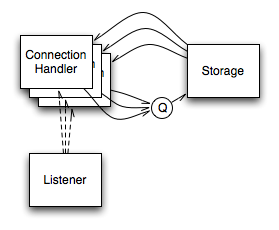Hello World in Go – A Memcached Server

I sat down last night to learn go. I’ve been a fan of concurrency-oriented languages since I wrote my first erlang program in early 2004 (which I still use). I’ve been itching to give go a go since the announcement.
The first thing I thought of that could naturally be modeled as a concurrent program was a memcached server. That has sort of become my “hello, world” as I have implemented the first python server for the memcached binary protocol (using asyncore), the main server (which Trond made beautiful), an erlang server, and a twisted server.
My go server has a lot in common with ememcached since both languages are concurrency oriented. There is one process/goroutine for managing the actual data storage, one for accepting TCP connections, and one for each connected user.
The TCP listener just accepts and spins up new processes or goroutines to handle the IO on the connections and then they wait for data. Once they’ve read a single request, they dispatch to the storage mechanism which will sequentually process each operation, regardless of input concurrency. Very simple, very easy to understand.
I mostly liked what I saw. The code feels a little C-like, but in practice is fairly intuitive and pleasant to work with. There are many reviews of the language and I’m not attempting to write one, but I will say that I got hung up on the lack of exceptions which required me to do weird error handling in sequential code.
The concurrency primitives remind me a bit of alef which I remember from early plan9 distributions, though I never actually got a chance to work with it before it got killed off. The one part of alef I really liked lived on in go, which further motivated me.
